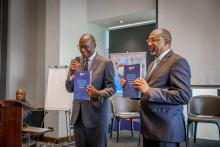Health labour market analysis support tool launched
Nairobi, Kenya – The World Health Organization, Regional Office for Africa launched the Health Labour Market Analysis (HLMA) Support Tool to assist countries assess their health workforce education capacity, supply, demand and need for health workers and facilitate integrating health workforce planning into Health Labour Marker Analysis.
The World Health Organization (WHO) in 2021 developed the Health Labour Market Analysis Guidebook, trained 75 experts from 25 countries in Africa. Building on this, the WHO designed a HLMA Support Tool which offers a novel workforce planning approach to estimate the needed health workers to address the disease burden of a country or geographical areas based on the essential service packages and the professional standards of care.
Following the launch, the WHO will build the capacity of about 50 international experts on the technical and practical aspects of conducting an epidemiology-based health workforce needs assessment and projections. The training component of the capacity building exercises is scheduled to hold from the 7th to 11th of October 2024 in Nairobi Kenya. This comes at a time when Member States are increasingly adopting this epidemiological approach to assess the need for health workers, to inform health workforce policy, strategy and investment plan development. The experts will contribute to a pool of regional experts that will support the growing number of Member States requesting for technical support.
Whilst launching the Tool and officially opening the training, Dr Abdourahmane Diallo, the WHO Representative in Kenya, emphasised that stimulating adequate and sustainable investment in the health workforce requires comprehensive insights into past and present health workforce dynamics and future projections under different scenarios, and that the HLMA Support Tool, which has already been used by 12 countries, is critical in achieving that outcome.
“The HLMA Support Tool allows users to assess education capacity, health workforce supply, demand and needs, and identify investment requirements for employment. I encourage you to fully engage in this training and build your capacity to support countries in conducting robust health labour market analyses” he stated.
Despite ongoing progress in developing the health workforce in the African region over the past few decades, projections indicate a potential shortfall of 6.1 million health workers by 2030, which is necessary to effectively tackle the Region's disease burden through comprehensive health promotion, disease prevention, treatment, rehabilitation, and palliation.
Also, nearly 27% of the trained health workers remain unemployed, underscoring a mismatch between training outputs and actual job creation. This gap requires a 43% increase in current funding levels dedicated to health workforce employment. A health labour market analysis, already conducted in 22 countries, is critical to stimulating policy reforms and investments to address these challenges.
The experts, after attending the workshop, are expected to apply the tool in support of Member States that request technical assistance related to health labour market analysis and will champion the generation of evidence needed to inform health workforce investment plans and compacts. These are critical milestones in the implementation of the Africa Health Workforce Investment Charter which was launched in May 2024.
Head, WHO Liaison office to the AU and ECA
Tel: +251-911-502162
Email: ntaganirai [at] who.int (ntaganirai[at]who[dot]int)
Communications and marketing officer
Tel: + 242 06 520 65 65 (WhatsApp)
Email: boakyeagyemangc [at] who.int (boakyeagyemangc[at]who[dot]int)







